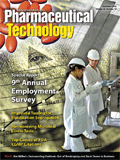Repaving K Street
Years of concentrating its political support on one side of the political spectrum may have eroded the industry's ties to the new majority.
Pfizer's stock price dropped 2.9% between the time the markets closed on Election Day and the following morning's opening bell, vaporizing about $5.7 billion in market capitalization. By the end of that week, the paper loss had grown to nearly $12.9 billion, about 6.8% of the company's total value. But by the close of the market a week later, on Friday Nov. 17, Pfizer's value had rebounded to pass its election-morning level. The values of other major pharmaceutical companies followed the same pattern.

Douglas McCormick
Pulling to the right
In the months before the election, the pharmaceutical industry rallied to support Republican candidates. According to OpenSecrets.org, which compiles figures on campaign donations and spending, the combined healthcare manufacturing sector—pharmaceuticals and health products—ranked 13th on the list of most generous campaign donors. Individuals working for drug and device companies, and their associated political action committees, donated $14.8 million to this year's races; 69% of that total went to Republican candidates, and about 94% went to incumbents of whatever affiliation.
Until the 1996 elections, the pharma industry split its donations about 55/45 (still favoring the Republicans). In that year, galvanized by the potential profit impact of impending healthcare reform, drug donations swung heavily onto the red side of the meter. Both the level of donations and the disparity in party support surged in the years that followed. In 2002, pharma poured more than $29 million into campaign coffers, sending almost three-quarters of those funds to Republican campaigns. Contributions have fallen in each of the elections since, but the industry has continued to favor Republican candidates with about two-thirds of its largesse.
Rooting for the top dog
The preference for incumbents explains some of the disparity. In this year's Senate fundraising, for example, our industry donated $1.4 million to Democrats, but $2.1 million to Republicans. The average donation per senator, however, was about $39,300, regardless of party affiliation—there were just more Republicans to donate to.
The House, however, presented a different picture. Of the $7.0 million raised from pharma and device donors, 73% went to Republican candidates, with average contributions more than twice as high as those going to their Democratic colleagues.
Unsurprisingly, five of the top recipients of drug-industry donations were members of the House Energy and Commerce Committee, which oversees food and drug safety and public health: Chairman Mike Ferguson (R-NJ), Nathan Deal (R-GA), Joe Barton (R-TX), Roy Blunt (R-MO), and ranking minority member and future chairman John Dingell (D-MI)
Why the heavy campaign spending? Why the Wednesday morning panic?
Fear, of course. Fear of drug price cutting, Medicare price negotiations, and reimportation. Fear that John Dingell, who has more than 50 years on Capitol Hill and a fearsome reputation as a critic of big business (except, of course, for his home-district auto industry), will return to chair the Energy and Commerce Committee.
A little silver lining
The shift in the House and Senate may bring the industry some positives, it's true: more funding for the US Food and Drug Administration (translating into more timely and higher quality inspections and reviews); extended research and development tax credits; and a brighter environment for the sort of scientific research that breeds new medicines.
Still, the fear remains. And the shift in the political balance happened so quickly that many on both sides of the aisle and both sides of the government–industry divide were caught unprepared.
The result is that, thanks to years of heavy support for a single political party and the K Street Project's success in making industry representation in Washington a Republican monopoly, our industry is in danger of finding that it has let its bridges to the left bank of the river tumble through neglect. As someone once said about counting on too much return from a single relationship, "Don't put all your begs in one ask-it."
On the day after the election, the leaders of the two branded-drug trade organizations—PhRMA's Billy Tauzin (US Representative from Louisiana, from 1980 to 1995 and as a Republican from 1995 to 2005) and BIO's Jim Greenwood (a six-term GOP Representative from Pennsylvania)—both issued statements pledging to work with lawmakers of both parties, and reminding the world that the US pharmaceutical industry is the world's well-spring of innovation.
To keep that promise of innovation, and to avoid being shut out of the decisions to come, we must rebuild the bridges and repave K Street. And time is short.
Douglas McCormickis editor in chief of Pharmaceutical Technology, dmccormick@advanstar.com

Drug Solutions Podcast: A Closer Look at mRNA in Oncology and Vaccines
April 30th 2024In this episode fo the Drug Solutions Podcast, etherna’s vice-president of Technology and Innovation, Stefaan De Koker, discusses the merits and challenges of using mRNA as the foundation for therapeutics in oncology as well as for vaccines.
PacBio Chosen as Tech Partner for Global Alzheimer’s Disease Research Project
April 23rd 2025The project, the North African Dementia Registry, will unite multiple entities for the purpose of developing a comprehensive dataset to advance the research community’s understanding of Alzheimer’s disease and other dementias in diverse populations.
Drug Solutions Podcast: Gliding Through the Ins and Outs of the Pharma Supply Chain
November 14th 2023In this episode of the Drug Solutions podcast, Jill Murphy, former editor, speaks with Bourji Mourad, partnership director at ThermoSafe, about the supply chain in the pharmaceutical industry, specifically related to packaging, pharma air freight, and the pressure on suppliers with post-COVID-19 changes on delivery.